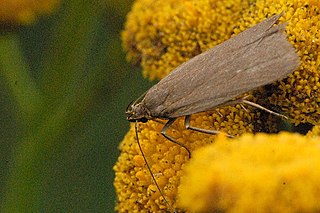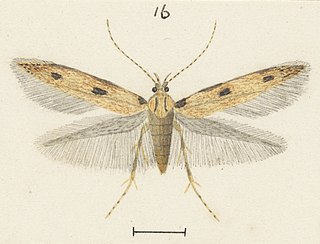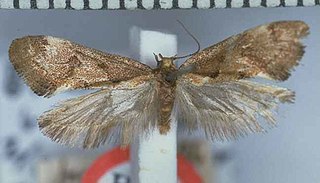Panicotricha is a monotypic moth genus in the family Gelechiidae. Its only species, Panicotricha prographa, is found in South Africa. Both the genus and species were first described by Edward Meyrick in 1913.
Phylopatris is a genus of moth in the family Gelechiidae. It contains the single species Phylopatris terpnodes, which is found in Brazil (Amazonas) and Peru.
Thriophora is a genus of moth in the family Gelechiidae. It contains the species Thriophora ovulata, which is found in South Africa (Gauteng).

Cataclysta lemnata, the small china-mark, is a moth species of the family Crambidae. It is found in Europe, Morocco and Iran.

Scoparia ambigualis is a species of moth of the family Crambidae described by Friedrich Treitschke in 1829. It is found in Europe and Asia Minor and possibly in Guangdong and Shanxi in China.

Eudonia truncicolella is a species of moth of the family Crambidae described by Henry Tibbats Stainton in 1849. It is found in China, Japan west to Europe.

Anania hortulata, the small magpie, is a species of moth of the family Crambidae. It is found in Europe and North America.

Scrobipalpa acuminatella is a moth of the family Gelechiidae. It is found in most of Europe, as well as Turkey, southern Siberia, Central Asia and China (Anhui). It was recently reported from Canada, with records from Ontario and Québec.

Agonopterix angelicella is a moth of the family Depressariidae. It is found in most of Europe, except the Iberian Peninsula and south-eastern Europe. It is also found on the Russian plain and Siberia and in Japan.

Heterocrossa gonosemana is a species of moth in the family Carposinidae. It is endemic to New Zealand.

Pyroderces aellotricha, also known as the Cosmet moth, is a moth of the family Cosmopterigidae. It is found in New Zealand, in Australia and the Cook Islands.

Pseudotelphusa paripunctella is a moth of the family Gelechiidae. It is found from most of Europe to Siberia and the Caucasus.
Torodora octavana is a moth in the family Lecithoceridae. It is found in Taiwan, India, and Sichuan, Kwanhsien and Zhejiang in China.

Labdia anarithma is a moth of the family Cosmopterigidae. It was described by Edward Meyrick in 1888. It is found in New Zealand and throughout Australia. Adults are on the wing from December to March and are day flying. They have been collected by sweeping bracken fern.
Helcystogramma epicentra is a moth in the family Gelechiidae. It was described by Edward Meyrick in 1911. It is known from Sri Lanka and China.
Phaeosaces lindsayae is a species of moth in the family Depressariidae. It is endemic to New Zealand. It is classified as "Data Deficient" by the Department of Conservation.

Scrobipalpa instabilella, the saltern groundling, is a moth in the family Gelechiidae. It was described by John William Douglas in 1846. It is found in on the Canary Islands, in Algeria, Ireland, Great Britain, Portugal, Spain, France, Belgium, the Netherlands, Germany, Denmark, Italy, Sardinia, Sicily, Greece, Cyprus and Palestine. It is also present in the United States, where it has been recorded from California.
Chlamydastis batrachopis is a moth in the family Depressariidae. It was described by Edward Meyrick in 1913. It is found in Peru.

Asaphodes albalineata is a species of moth in the family Geometridae. It is endemic to New Zealand and has been observed on Stewart Island / Rakiura. This species is similar in appearance to Asaphodes oraria but can be distinguished as it has an unusual pattern on the underside of its hindwings. It inhabits open hill tops and adults are on the wing in December.

Tingena brachyacma is a species of moth in the family Oecophoridae. It is endemic to New Zealand and has been found in the south of the South Island. This species inhabits open swamps, native forest and scrubland and has been collected amongst Leptospermum. The adults of the species are on the wing in November and December.











